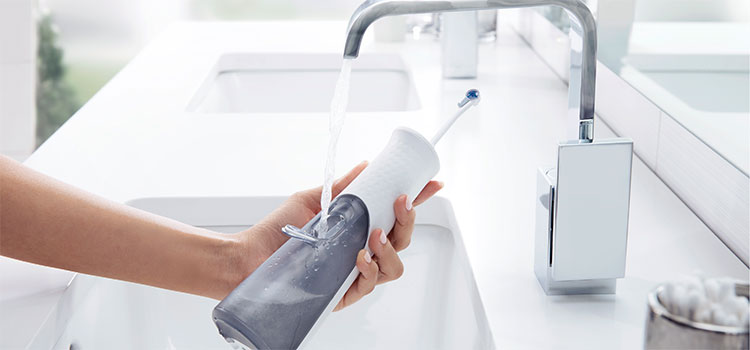Your oral hygiene has a major impact on your overall health. This is the reason why doctors stress brushing and flossing every day. While brushing the teeth is a process everyone follows religiously, flossing is often ignored. Flossing your teeth helps clear out food and plaque that may be stuck in the deeper recesses where the toothbrush cannot reach.
A string floss is used in the traditional flossing method. However, now there is a less invasive method to floss your teeth. For this, you can use a water flosser.
What Is A Water Flosser?
A water flosser is also known as a dental irrigator. It is a dental floss that uses a pressurised stream of water to floss between the teeth gaps and in gum pockets. This is a handheld device that comprises a water storage unit, a motor, and a nozzle. It offers various pressure settings.
Unveiling The Benefits Of Using A Water Flosser
Flossing your teeth is very important to maintain good oral health. If the classic way of flossing seems tedious, you should use a water flosser. Here are some of the benefits of using one.
● Effective Removal of Plaque and Tartar
One of the main benefits of using a water flosser is that it can efficiently remove plaque and tartar from areas that your toothbrush or string floss cannot reach. The pressurised water reaches deep within the teeth and gum line and dislodges plaque.
● Reduced Risk of Gum Disease
Plaque and tartar that are left unchecked can cause buildup. This can lead to gum diseases. A water flosser removes the plaque and bacteria from even the hard-to-reach places in the mouth, thereby preventing gum diseases like gingivitis and periodontitis.
● Gentle on Gums
The string floss, if not used carefully, can cause bleeding of the gums. Thus, people with sensitive gums shy away from using it. A water flosser works gently on the gums without irritating them. What’s more, with its varied water settings, you can adjust the water pressure.
● Safer for Dental Implants
Dental implants may be stronger than natural teeth, but you still need to care for them, especially the gums around them. Any aggressive method of cleaning can affect the tissues around the implants. However, a water flosser is very gentle and, hence, a safer option for dental implants. It will clean the tissue around the implants effectively.
● Ideal for Braces
If you have braces, using a dental floss can be difficult. The string may get stuck in the braces, causing discomfort. Not using floss is not an option, as food gets stuck on the braces, too. A water flosser is the best way to floss when you have braces, as it projects a jet of water onto your teeth, cleaning the gaps and the braces efficiently.
● Perfect for People with Medical Conditions
People who are unwell or have mobility issues may find it hard to make their way to the bathroom for brushing and flossing. A portable water flosser is a boon for such people as it gives them an easy, oral deep cleaning option.
● Reduce Oral Bacteria
Your mouth is a breeding ground for bacteria. The acid in your mouth creates a feasible environment for these to grow and thrive on your teeth, tongue, and even cheeks. Using a water flosser can help eradicate these effectively.
● Key to Complete Oral Hygiene
No matter how much time and care you give to brush your teeth, scrape your tongue, and rinse your mouth with mouthwash, your oral hygiene routine is incomplete without flossing. If a traditional floss is not your cup of tea, a water flosser can simplify the process for you.
How To Use A Water Flosser?
Using a water flosser before brushing your teeth can help in dislodging the food particles that may be stuck in hard-to-clean spots in your mouth. Here’s how you should use a water flosser.
Step 1: Get the Water Source Ready
This depends on the kind of water flosser that you are using. If you are using a handheld water flosser, fill up its water reservoir. If you are using a bigger water flosser, connect it to a tap. Make sure that you are using lukewarm water.
Step 2: Check the Placement
Don’t hold the nozzle of the water flosser directly against your teeth and gums. Instead, hold it at a distance from them. Start from your molars and move forward. It is advisable to lean over a sink to avoid water splashes on the countertop.
Step 3: Select the Settings
To switch on the dental flosser, you may have a button or a dial. Start with the lowest water pressure setting and increase it as per your comfort. It is important to note that the pressure should neither be too low nor too high.
Step 4: Treat the Gum Line
Flossing along the gum line is a good idea. Project the water jet on each tooth covering the top, baseline, and gaps. Make sure to hold the water on each tooth for at least two seconds before moving on to the next. The whole flossing process may take about two minutes to complete.
Step 5: Empty the Water Flosser
Once you are done with the flossing and satisfied with the result, it is time to turn off the device and empty the water in the tank. It is not advisable to keep the water in the flosser as it may lead to bacterial growth. Rinse the reservoir properly and let it air dry before storing it. This should be done after every use.
Conclusion
Flossing has its benefits, and a lot of people, including dentists, swear by it. Traditional flossing can hurt your gums if not done properly. A water flosser is a gentler, more fun way to floss your teeth. So, if you have been shying away from flossing for various reasons, it is time to get a water flosser and elevate your dental hygiene.





Be First to Comment